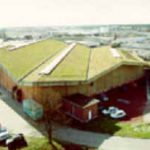
Additional Resources
See the profile on the ECOVER website here. Visit the Floradak supplier, Green Roof Tools bvba, here: http://www.floradak.be/referenties.php?item=Ecover_fabriekshal&m=testimony. Read the informative “TreeHugger Gets The Inside View on Ecover’s Eco-Friendly Cleaning Products” by Leonora Oppenheim of 7.22.08 in TreeHugger here.
In a concerted effort to minimize the burden on the environment, ECOVER designed and built in 1992 what they refer to as “the world’s first ecological factory,” ( www.ecover.com ). ECOVER is a manufacturer of biodegradable laundry and other “green” products located in Oostmalle, Belgium. Their ecological construction priorities included the choice of building materials, integration into the environment, energy consumption and recycling. Some of the factory features include:Skylights aligned with path of the sun to ensure a minimal use of electricity;Sedum roof for insulation, minimizing the need for extra heating or cooling;Water filtration system on site for minimal waste:Machine pipes cleaned with a PIG (a suction device that goes through pipes after each batch and helps minimize the need for water);Bricks made from recycled coal waste and wood made from renewable/sustainable forests.
A 5,000 square meter (approximately two acres) roof of meadow grasses was installed on top of the multiple saddle roof, which undulates playfully. The greenroof consists of various layers, with an extra insulation layer of perlite and also a waterproof layer followed by the thin substrate layer. It acts as an efficient soundproofing material and temperature regulator/insulator during the summer and winter months. In the summer the grasses absorb much of the direct heat and during winter they hinder cool air circulation and processes. Waste water is naturally purified on-site and used to water the greenroof in the summer. Little maintenance is required; the greenroof is mowed twice a year and weeded as necessary.Early problems of water leakage and summer plant root burn had to be contended with. Faulty adhesion of the waterproofing membrane to the roof was amended and insufficient soil substrate depths have been corrected. More drought tolerant plants, such as sedums, included in the planting plan may have alleviated the summer heat issue on the grasses (J. William Thompson, LAM, May 1998).
 Greenroofs.comConnecting the Planet + Living Architecture
Greenroofs.comConnecting the Planet + Living Architecture









